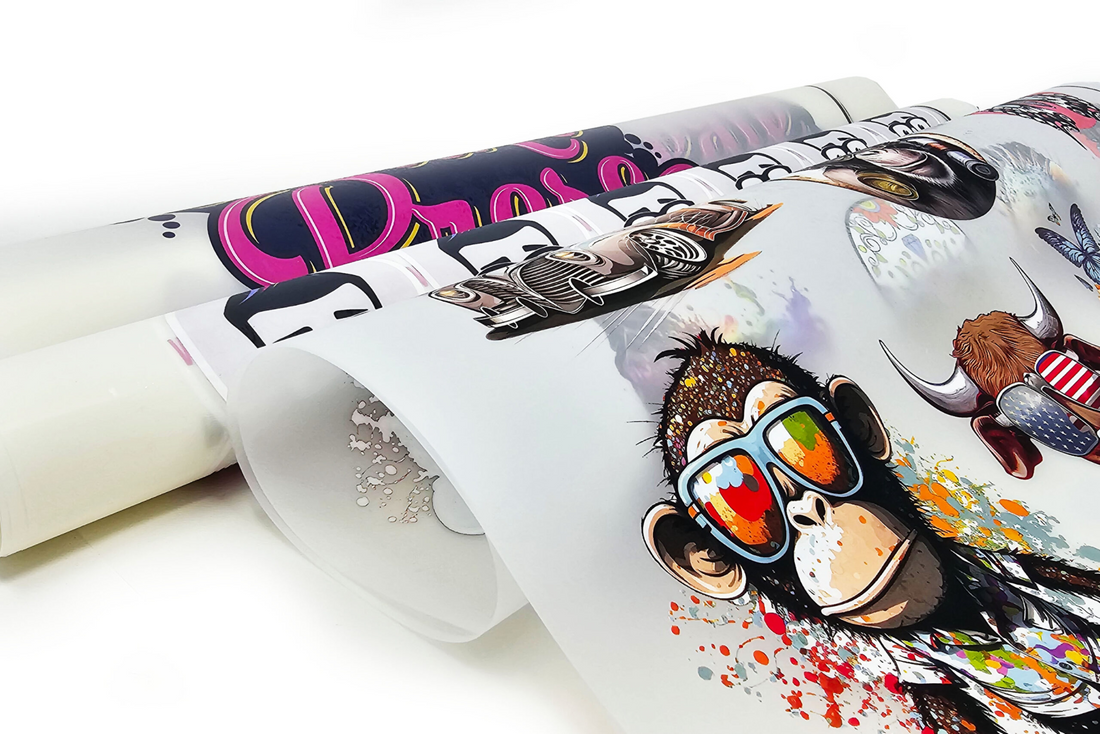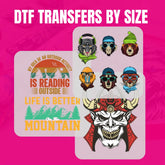DTF Transfer Paper: How to Choose the Right One for Your Prints
Selecting the ideal DTF transfer paper is crucial for achieving excellent prints with vivid colors and long-lasting durability. Given the abundance of possibilities, finding the right one that fits your DTF printing machine and printing requirements might be taxing. Choosing the correct transfer paper guarantees great results whether you are running a commercial printing company or making personal custom DTF transfers.
Step 1: Understand the Role of DTF Transfer Paper
Before it is laid onto cloth or another surface, the printed design is held on DTF transfer paper. DTF paper differs from conventional heat transfer paper in that it uses DTF heat transfers—printing straight onto the film before applying adhesive powder and heating it. Selecting the incorrect paper could cause problems, including faded prints, inadequate adhesion, or trouble peeling the film following press-through.
Step 2: Choose Between Hot Peel and Cold Peel Paper
DTF transfer paper comes mostly in two varieties: cold and hot peel. For high-production environments, when speed counts, hot peel paper lets you remove the film right after pressing. Conversely, cold peel paper requires waiting for it to cool before peeling, therefore producing more robust and sharp designs. Cold peel paper is often the better option if you are printing complex or elaborate artwork.
Step 3: Consider the Fabric Compatibility
Certain textiles benefit from different DTF transfer paper varieties. While some papers are better suited for polyester, mixes, or non-fabric materials like wood and leather, others shine especially on cotton. If your DTF printing company handles several kinds of fabric, you should pick a flexible paper that can manage various textures without sacrificing print quality.
Step 4: Evaluate Image Quality and Ink Absorption
DTF transfer paper absorbs ink effectively without bleeding or smudging, which is essential for high-resolution prints. The best papers guarantee sharp details and improve color vibrancy. Perfect for professional DTF heat transfers requiring premium quality, coated transfer paper typically holds ink better than uncoated versions. If your designs call for gradients or fine details, choose a paper with great ink saturation free of distortion.
Step 5: Check for Durability and Washability
Durability is one of the main issues about tailored DTF transfers. Excellent DTF transfer paper should ensure the design resists several washes without breaking, peeling, or fading. Certain papers are made for increased durability, providing longer-lasting prints even with normal wear and washing. Test the transfer paper on several fabrics and wash the samples to find how well they hold up before making a bulk buy commitment.
Conclusion
Professional-grade DTF heat transfers with long-lasting quality depend on the correct DTF transfer paper. Consider fabric compatibility, picture clarity, and durability to guarantee your prints satisfy consumer expectations. Investing in premium transfer paper will improve whether you run a business or print for personal projects. To get the best DTF transfer sheets and supplies, visit DTF Transfer Art for premium options tailored to your printing needs.
- Blended fabrics for DTF
- bulk dtf transfers
- bulk printing
- cost-efficient printing
- Cotton for DTF
- Custom apparel
- custom apparel printing
- Custom clothing printing
- custom gangsheet
- Custom gangsheet DTF transfer sheets
- Custom gangsheet printing
- Custom Gangsheets
- custom heat transfers
- Custom iron patches
- custom prints
- decal transfer
- decal transfers
- Design preparation
- Digital printing
- Direct-to-Film Transfer
- dtf business
- DTF gangsheet
- DTF Heat Press
- dtf print shop
- DTF printer supplier
- DTF Printing
- dtf transfer
- dtf transfer art
- dtf transfer film
- dtf transfer instructions
- dtf transfer paper
- DTF transfer paper suppliers
- dtf transfer printer
- dtf transfer sheets
- DTF transfer supplier
- DTF transfer wholesale
- dtf transfers
- dtf transfers near me
- dtf transfers ready to press
- dtf transfers wholesale
- DTF vs Screen Printing
- DTF vs Vinyl
- DTF vs. iron-on
- dtf wholesale
- gangsheet printing
- heat press printing
- Heat press settings
- Heat settings for DTF
- heat transfer decals
- heat transfer method
- heat transfer printing
- Heat transfers
- hoodie printing
- Hoodies
- hot peel DTF
- iron-on decals
- Leather DTF transfers
- Local print shops
- Mild detergent for DTF prints
- Nylon DTF transfer
- Peeling or cracking prevention
- Polyester for DTF
- premium DTF transfers
- print on demand
- Print shops near me
- Printed designs durability
- Printing companies
- Printing methods
- Quality printing
- reliable DTF transfer printer supplier
- Screen printing
- Spandex DTF transfer
- sticker printing
- Stretch fabrics DTF
- Sublimation printing
- t shirt printing
- T-shirts
- Textile printing
- Tote bags
- Transfer printing
- trustworthy DTF transfer supplier
- Washing care for DTF prints
- water slide decals
- what is dtf transfer






